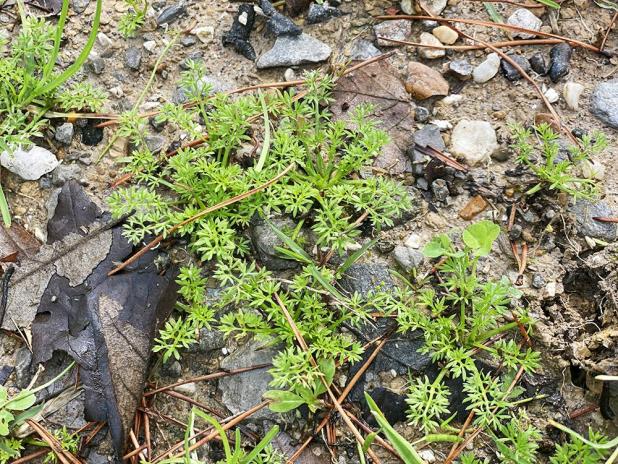
Control stickerweed before seeds set and become a literal pain in the spring.
—LSU AgCenter/Heather Kirk-Ballard
Get It Growing: For a healthy spring lawn, get to work now
Your lawn or turfgrass may be the last thing on your mind right now — but it’s no time to sit back on your laurels. Lawns are in their winter dormancy, and we have all enjoyed the reprieve from lawn mowing. But it won’t be long before our lawns literally “spring” back to life.
If you want to give your turfgrass a leg up this spring, it’s time to get to work now. Despite our lawns’ winter slumber, weeds are still at work. If you look out into the lawn, you will likely see plenty of weeds.
Now that lawns have gone brown, weeds are very evident; the green signifies they are alive and well.
Broadleaf weeds such as clover and lawn burweed (stickerweed) in addition to annual bluegrass are often present. These weeds will be found in lawns of St. Augustine, centipede, zoysia and dormant bermuda. They can be managed with applications of atrazine herbicide applied in winter from January into the spring until temperatures get up into the upper 80s.
The winter months are a good time to spray cool-season annual weeds while they are actively growing. It is especially important to treat these weeds before they produce seeds that will be a headache in the next growing season.
Herbicides containing three-way mixtures of 2,4-D plus dicamba plus mecoprop — such as the Trimec product — can be used for winter broadleaf control with less turf injury potential in all Southern turfgrasses this time of the year. Weed-and-feed products can be substituted as your first application of fertilizer, but not until the early spring after the threat of the last freeze has passed. In south Louisiana, that date is typically March 15, and in north Louisiana, April 1.
Warm-season turfgrasses that are not actively growing should not be fertilized with nitrogen unless the lawn has been overseeded with ryegrass. Nitrogen fertilization on dormant turfgrasses can lead to increased fungal diseases such as brown patch and also lead to winter kill. In addition, nitrogen applications during this time have a greater potential for movement into ground water.
Although many home lawns do not require regular mowing or fertilization, now is an excellent time to have your soil tested. To test your soil, bring in 1 pint of soil to your parish LSU AgCenter office. Soil samples should be a composite of soil plugs 4 inches in depth from various places around the lawn.
For those who have chosen to overseed with ryegrass, apply 2 to 3 pounds of ammonium nitrate or equivalent fertilizer per 1,000 square feet every four to six weeks to maintain desired growth and color.
Postpone any permanent warm-season turfgrass establishment from seed until next spring. Sod such as St. Augustine can be laid during winter if necessary, but remember to keep it moist to prevent drying out and dying. Establishment is best left until well after spring green-up. Areas that are thin or bare can be overseeded with ryegrass to reduce muddy conditions or prevent soil erosion.
Brown patch diseases can come and go throughout the winter if the weather is mild as it typically is here in Louisiana. Treatment with fungicides containing thiophanate, propiconazole, iprodione, PCNB, captan, triadimefon or maneb will reduce brown patch spreading. Damage from brown patch will slow spring green-up and affected areas will remain unsightly until warmer weather conditions allow for turfgrass recovery.
Warm-season turfgrasses may show signs of green-up in south Louisiana in late February. Do not push turfgrass growth with fertilizer. Fertilizer applied too early will feed the winter weeds, and fertilizer applied too heavily will result in lush growth that is more susceptible to injury from late frosts or brown patch. Let the grass green up gradually, and do not fertilize until after the first mowing. Remember, irrigate only as needed. Grass will be greener on the other side of winter, but for now, control weeds and brown patch to get ahead of the game for spring.
